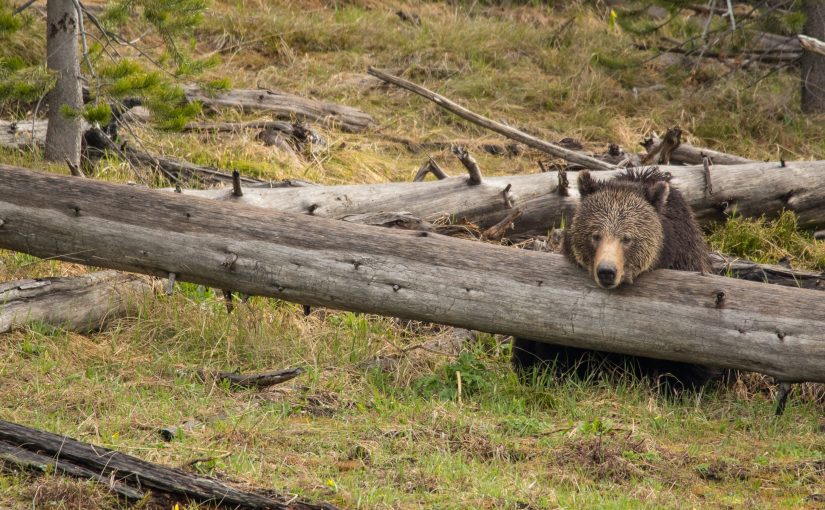Memorial Day Weekend marks the beginning of the summer season and the start of intense crowds in the greater Yellowstone area. But the summer season does not mean summer weather! It’s still variable with cool nights and snow-covered campsites.
Yellowstone May 20: Wapiti Wolves and Fog
It was supposed to be a relatively clear day, but Yellowstone had other plans. Which happens a lot. There was a decent snowstorm earlier in the week, and I think that may pushed some of the wildlife out of Hayden Valley to lower elevations. That’s not to say there wasn’t anything to see, it just took a lot more patience.
Yellowstone May 6: Hayden Valley Bear and Canyon Carcasses; Snow Report
Back at Madison for the evening. What a difference in the weather! My car thermometer reported 60 degrees at the campsite. It was nice not bundling up so much this time.
After making camp, I’ll go park at a turnout somewhere along Madison River to eat my sandwich. There was an unidentified K-9 wandering through and bison/elk in the area. Some red dogs starting to show up in this area as well.
Continue reading Yellowstone May 6: Hayden Valley Bear and Canyon Carcasses; Snow Report
Yellowstone April 29 – 30: Lamar Wildlife, Tower Bears, and Canyon Snow
The days leading up to this weekend was very wintery. Thursday morning Teton Valley had several inches of snow on the ground. It’s pretty, but I’m sort of over it.
Continue reading Yellowstone April 29 – 30: Lamar Wildlife, Tower Bears, and Canyon Snow
Photography Workflow Part 4 – Sharing, Printing, and Publishing
After going through the previous articles in this series, all of your photos should be in a single Lightroom catalog. It’s the central repository of your work. Now that the images are in their resting (archived) place, it’s time to export a few to the world. Continue reading Photography Workflow Part 4 – Sharing, Printing, and Publishing
Photography Workflow Part 3 – Lightroom Tagging & Edits
In this part, we are finally getting into Lightroom. This is my program of choice to keep my entire photo library organized. Some editing techniques require integrating Photoshop, but Lightroom is great for general processing and cataloging. Continue reading Photography Workflow Part 3 – Lightroom Tagging & Edits
Photography Workflow Part 2 – The Inbox
Part 1 of this series was a bit of opinion and rambling. Now we get into some fast-paced instruction. After the photo shoot, you are back at the workstation ready to offload all those cards – let’s go! Continue reading Photography Workflow Part 2 – The Inbox
Photography Workflow Part 1 – Intro & The Hardware
You capture an epic moment. Eager to show it to the world, you race home, copy the photos to a random folder, and toss up a quick edit to social media. Success! People like it.
The next weekend you capture another epic moment. Eager to show it to the world, you race home, copy the photos to another random folder, and toss up a quick edit to social media. Success! People like it.
Repeat this cycle for months (or maybe years). People love your work, and your photo library is growing. Continue reading Photography Workflow Part 1 – Intro & The Hardware
The Importance of Leveling Photos
Keeping the camera level is easy when there is a visible horizon, but not so much when shooting action (maybe even with misleading points of reference). That’s what happened when I was shooting a snowmobile race held on a steep slope – I found myself leveling to the rider, and not the terrain.
Since the extreme-factor of this event is the steepness, leveling out the slope doesn’t look as good, and I had to correct almost every image in post. Some of them did not have enough space to avoid over-cropping. Thankfully Photoshop has a way to fill-in missing parts in a couple quick steps. Continue reading The Importance of Leveling Photos
Canon EOS 5D Mark IV
So far in my journey through photography, I have shot with a Canon T3i and Canon 7D Mark II. I have rented the 5D Mark III a couple times, but mostly have been a user of crop-sensor bodies. When shooting with the smaller sensors, it’s helpful to use glass made for crop bodies, like the Sigma 17-50 2.8 or the Canon 55-250 IS STM II. But there are other lenses I have like the Tamron 150-600, where a full-frame sensor could make better images.
In this brief overview, I’m going to share what it’s like to shoot with this camera alongside the 7D II. There will be little comparisons across other manufacturers, like Nikon or Sony. It’s true that you can squeeze another megapixel or two, slightly more DR, etc. from competing cameras. But I wanted a body that played nice with the equipment I already had.
